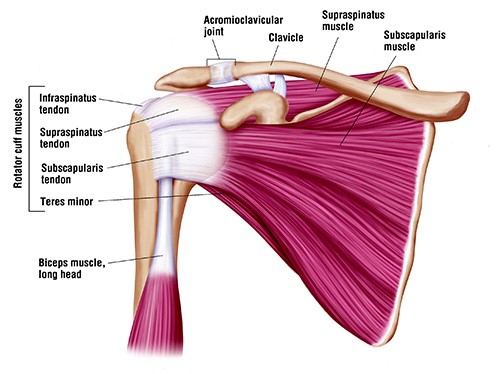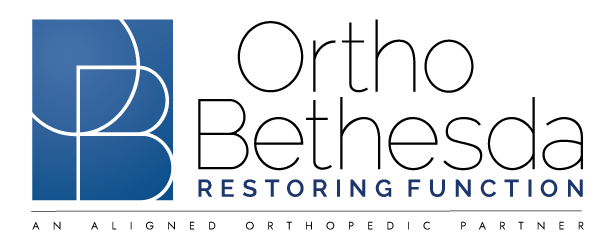Rotator Cuff Tear
Your doctor has told you that you have a rotator cuff tear. What does this mean?
The rotator cuff is a group of tendons in the shoulder joint that cover and provide support to the shoulder joint, enabling a wider range of motion. A rotator cuff tear involves one or more of the four muscles that starts on your shoulder blade, the scapula, and inserts on your upper arm, or humerus. These 4 muscles work together to lift and rotate your arm and keep the ball of the shoulder joint (proximal humerus) centered on the socket (glenoid). Although there are 4 separate muscles they share a common tendon – tendons attach muscles to bone. This group of tendons is called the rotator cuff. A tear in the rotator cuff is one of the most common causes of shoulder pain in middle-aged adults and older individuals. It may occur with repetitive movements while working or playing sports, during motor accidents, lifting a heavy object, or a fall on an outstretched arm. As aging occurs, bone spurs may develop and can damage tendon tissue causing tears.
Rotator cuff tears cause severe pain (even at rest), weakness, and a crackling sensation on moving your shoulder in certain positions. There may be stiffness, swelling, loss of movement, and tenderness in the front of the shoulder.
Rotator cuff tears can be diagnosed with a medical review and thorough physical exam and confirmed following X-ray, magnetic resonance imaging (MRI), or ultrasound. Symptomatic relief may be obtained with conservative treatments including rest, shoulder sling, pain medications, NSAIDs, steroidal injections, and shoulder exercises. However, surgery is required when these methods do not help relieve symptoms. Rotator cuff repair may be performed by traditional open surgery (involving a large incision) or minimally invasive with arthroscopy (a lighted narrow fiber-optic tube with a camera is inserted through tiny incisions). Surgery may involve removal of bone spurs, repairing and re-attaching torn tendons with suture anchors to the shoulder bone, and sometimes transferring a functional tendon (graft) from its original location to restore function. Following the surgery, you may be advised to practice motion and strengthening exercises.
How it Happens
The muscle that is most commonly torn in a rotator cuff tear is the supraspinatus. This muscle lifts your arm up over your head. It has a poor blood supply where its tendon inserts on your shoulder and this alone makes it very likely to degenerate and tear as we get older – or less young, as I like to say. To make matters worse, if you have a bone spur it can press on this tendon and interfere with its blood supply even more or scratch the tendon until it tears.
The largest muscle of the rotator cuff, the subscapularis, starts on the front of the shoulder blade and its tendon inserts on the front the shoulder. This muscle rotates your hand to your stomach when your elbow is at your side, called internal rotation. It is very important in keeping the ball centered in the socket, so when it completely tears it should be repaired. It is also important because the area where it inserts on your shoulder forms a wall behind which glides the tendon of your biceps. Tears here can cause the biceps tendon to jump out of its groove. If the biceps tendon continues to do this it can cut through the subscapularis tendon.
On the back of your shoulder blade are the infraspinatus and teres minor muscles. Together these muscles do the opposite of your subscapularis and externally rotate your arm, like when you rotate your hand away from your stomach with your elbow at your side. This makes them important for getting your hand to your mouth or the back of your head.
Why Do I Have a Rotator Cuff Tear?
Rotator cuff tears occur for a variety of reasons. Most commonly the rotator cuff tears after an accident or injury. You may have a fall or you were lifting something and felt a pull or tear. The tendon may have been weakened from age related wear and tear. Some people have a spur on the edge of the point of the shoulder, called the acromion, that rubs on the tendon and weakens it over time. The end result will be pain down the front and outer part of the arm, often worse with activity or at night when we are trying to sleep. You may feel weakness when you try to reach your hand up or behind your back. It is best to have your shoulder evaluated by an orthopedic surgeon in these cases.

 ">
">
Get in Touch
Call OrthoBethesda About Treating Your Rotator Cuff Tear
A torn rotator cuff can be extremely painful and limit you to how much you can do physically. That’s why it’s important to contact the experts for orthopedic treatment to improve the quality of your life. Contact OrthoBethesda to make an appointment or call us at (301) 530-1010 today!
